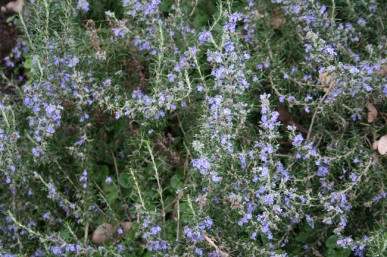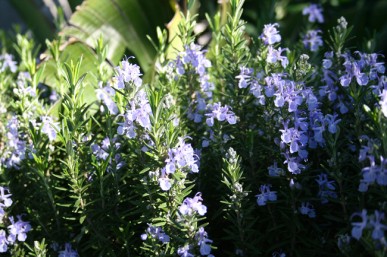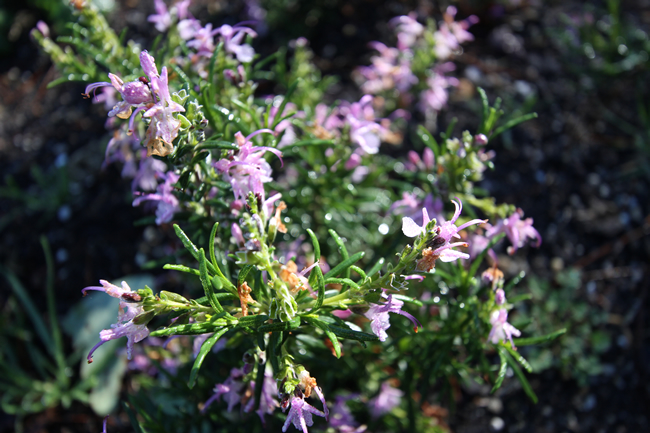Rosemary (Rosmarinus officinalis), a native of the Mediterranean, is a woody shrub which can grow to a height of 1 m. It has short, tough leaves densely bunched on the stems, and pale blue flowers in winter. There are several cultivars including ‘Tuscan blue’ and ‘Blue lagoon’, which are dwarf forms with dark-blue flowers; ‘Roseus’ with pink flowers; ‘Albus’ with white flowers; ‘Aureus’, which has leaves speckled with yellow; and ‘Prostratus’, a prostrate form. Most rosemaries can be grown from seed sown in spring and all grow well from cuttings taken in spring or summer. Rosemary likes a sunny, well-drained position with a slightly alkaline soil. It can be slow growing at first, but will need to be pruned regularly after the first two years. The prostrate and dwarf varieties are excellent for rockeries or hanging baskets. Harvest rosemary whenever it is needed.
Rosemary was revered in Ancient Greece and Rome where it had a reputation for strengthening memory and was a symbol of fidelity. During the fourteenth and fifteenth centuries, rosemary was burnt to ward off ‘foul humours’ and contagious diseases, especially the plague. It was also believed that if rosemary were placed under your pillow ‘thou shalt be delivered of all evill dreames’. Sir Thomas More let it run wild in his garden ‘not only because the bees love it, but because the herb is sacred to remembrance, and therefore, to friendship’. In Australia, it is worn on Remembrance Day and Anzac Day to remember those lost in war. Cuttings taken from plants growing in Gallipoli have been grown into bushes in Australia and every year these are picked and sprigs given to those marching in the parade.
Medicinal remedies
Both the fresh and dried leaves can be made into a tea and drunk to sweeten the breath; as a tonic for the circulatory system; to ease the symptoms of colds or flu; to lift the spirits, lessen tension and alleviate mild depression; to ease indigestion and flatulence as well as headaches and migraine. If you regularly drink rosemary tea it stimulates blood flow to the brain and improves memory and concentration
Make an infused oil by placing about 200g of fresh rosemary into a heat resistant bowl or the top of a double boiler. Cover the rosemary with oil (almond, olive or sunflower) and place over or in saucepan of cold water. Slowly bring the water to the boil. Heat gently (it’s important the oil doesn’t boil) for 2-3 hours. Strain the oil through muslin, squeezing well and discard the rosemary into the compost. Pour into clean dark glass jars, seal and label with date and name. Store in a cool dark place.
Use this oil as a rub for sore muscles, sciatica and neuralgia. Rub it into the scalp and hair before washing to promote hair growth, add gloss and lessen dandruff. Rub it in wrap in a hot towel and leave for 10 minutes. Then wash. This is also particularly good for dry hair and scalp.The cooled tea made from the leaves can be used as a final hair rinse for the same purpose. Strong infused rosemary oil can help to get rid of lice and nits (add infused lavender, tea-tree and thyme oils for greater effect). Rub into the hair and scalp, leave over night and wash out in the morning.
Use the recipe above but add three crushed or finely chopped cloves of garlic to half a cup of infused rosemary oil. Leave to steep for an hour and then strain. Rub this into the scalp after dampening the hair and leave for about an hour. Rinse off and wash the hair. Kathy says, ‘The olive oil moisturises the scalp and the garlic and rosemary remove any dead skin. If the dandruff is quite bad I recommend you do this once a week’.
This recipe and much of the information in this article is from my book Grow Your Own Herbal Remedies, borrow it from your library, buy it from your local bookshop or go to our online store by clicking here





